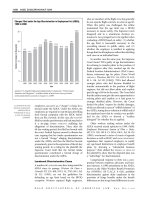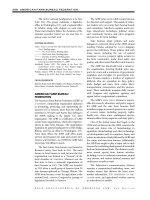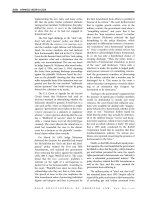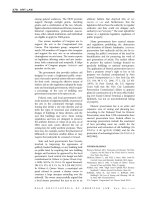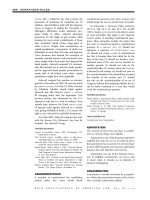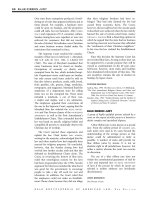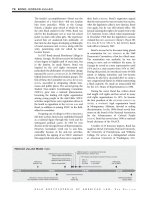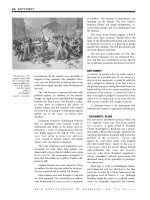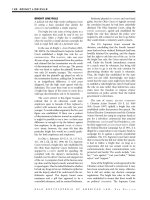Gale Encyclopedia Of American Law 3Rd Edition Volume 11 P41 pptx
Bạn đang xem bản rút gọn của tài liệu. Xem và tải ngay bản đầy đủ của tài liệu tại đây (143.11 KB, 10 trang )
instruction all qualified candidates, to the extent
of its capacity, without religious, racial, or social
distinction.” Id., at 435-36, 88 A. 633. The court
relied on a series of sister state public spending
cases that distinguished private colleges like
Connecticut College from public universities
open to all qualified candidates, ultimately
concluding that the grant of the eminent
domain power was unconstitutional because of
the exclusively private benefits from that grant
of the eminent domain power to a private
condemnor. Id., at 438-39, 88 A. 633.
We most recen tly restated the rule of
Connecticut College in Carofano v. Bridgeport,
196 Conn. 623, 632, 495 A.2d 1011 (1985),
wherein this court rejected a claim that General
Statutes § 7-473c, the mandatory binding
arbitration statute, was an unconstitutional
delegation of the legislative power because
“the arbitrators are not public officials account-
able to the electorate.” The court in Carofano
discussed, inter alia, delegations of the eminent
domain power, and cited Connecticut College as
standing for the proposition that “the delega-
tion of the governmental power of eminent
domain to private persons rathe r than to public
officials has frequently been approved where a
public purpose is thereby advanced and where the
benefit of the property taken is considered to be
available to the general public.” (Emphasis
added.) Id., at 633, 495 A.2d 1011. Indeed, this
court “perceive[d] no inherent vice that should
preclude enlistment by the legislature of private
individuals or agencies to achieve a public
purpose by the exercise of a governmental
power so long as adequate safeguards are
provided. Although elected officials and those
appointed by them as public officers may be
more directly answerable to the electorate for
their doings, the principle of accountability
remains viable in the ability of legisla t ors to
terminate or modify any delegation of legislative
power that has been made and in the ultimate
authority of the people to change the law by
electing those amenable to the public will.” Id.,
at 633-34, 495 A.2d 1011.
Although Carofano v. Bridgeport, supra,
196 Conn. at 633-34, 495 A.2d 1011, is not an
eminent domain case, we find persuasive its
rearticulation of the Connecticut College formu-
lation that is applicable when the eminent
domain authority has been delegated to a
private entity. Its emphasis on public purpose
and benefit is more harmonious with the well
established purposive approach that we follow
presently in resolving questions of public use,
than the claim that Connecticut College requires
actual access by the public. See, e.g., Olmstead v.
Camp, supra, 33 Conn. at 551. Indeed, this
court implicitly recognized this in Gohld Realty
Co. v. Hartford, supra, 141 Conn. at 143-44, 104
A.2d 365, when the court concluded that the
rule of Connecticut College did not apply
because, “[i]f the public use which justifies the
exercise of eminent domain in the first instance
is the use of the property for purposes other
than slums, that same public use continues after
the property is transferred to private persons.
The public purposes for which the land was
taken are still being accomplished.” Moreover,
the Carofano approach to delegation analysis is
especially compatible with the concept that
many governmental endeavors, such as eco-
nomic development or urban renewal, may be
accomplished more expeditiously when govern-
mental authorities are afforded the opportunity
to utilize the expertise and resources of the
private sector. Accordingly, we conclude that
Carofano sets forth the appropriate standard to
apply to the eminent domain delegation in the
present case.
We now apply the Connecticut College
standard, as articulated in Carofano v. Bridge-
port, supra, 196 Conn. at 633-34, 495 A.2d
1011, to the delegation in the present case.
75
At
the outset, we note that it is undisputed that the
development corporation is a private entity. We
next turn to the second prong, which itself is
bifurcated into two factors: (1) whether “a
public purpose is thereby advanced”; and (2)
“where the benefit of the property taken is
considered to be available to the general
public.” Id., at 633, 495 A.2d 1011. Accordingly,
we also note that we previously have concluded
that the development plan in the present case
constitutes an economic development plan that
is, by itself, a public use or purpose under either
the federal or state constitution. See part II A of
this opinion. The “advancing a public purpose”
75
The power of eminent domain, which emanates from the
state legislature; see, e.g., Northeastern Gas Transmission Co.
v. Collins, supra, 138 Conn. at 586-87, 87 A.2d 139; initially
had been granted to the city through chapter 132 of the
General Statutes. See General Statutes §§ 8-186, 8-193(a)
and 8-199. The plaintiffs did not challenge this initial grant
to the city, only the subsequent grant from the city to the
development corporation.
GALE ENCYCLOPEDIA OF AMERICAN LAW, 3RD E DITION
MILESTONES IN THE LAW KELO V. CITY OF NEW LONDON 387
SUPREME
COURT OF
CONNECTICUT,
MARCH 2004
factor, therefore, is satisfied because the delega-
tion effectuates the public purpose directly, by
giving the development corporation the power
to acquire real property for the implementation
of the development plan.
A more complex inquiry in the present case,
however, is whether “the benefit of the property
taken is considered to be available to the general
public.” Carofano v. Bridgeport, supra, 196
Conn. at 633, 495 A.2d 1011. The plaintiffs
claim that, under Connecticut College, availabil-
ity to the general public requires public entrance
into, or the benefits of tenancy in, the office
buildings planned for construction on parcel 3.
They further claim that such direct benefit is
unavailable because the tenants will be selected
solely by Corcoran Jennison, and not the
development corporation or the city.
76
The
defendants contend, in response, that direct
access is not required because the public use of
economic development necessarily requires the
development corporation to turn the property
over to private developers and their tenants, and
that the development corporation is, unlike the
college in Connecticut College, not acting in
furtherance of its own benefit. We agree with
the defendants.
We note that the Connecticut College rule as
stated in Carofano, requires only that the
“benefit” of the taking be available to the
general public. Id. We conclude that the public
benefit of the taking in the present case is the
dramatic economic benefit that the develop-
ment plan is expected to have for the public in
the New London community, namely, the
massive projected growths in employment and
tax and other revenues. Indeed, the rule of
Gohld Realty Co. v. Hartford, supra, 141 Conn.
at 144, 104 A.2d 365, is particularly applicable,
because in the present case , the public use and
benefit in the first instance is the economic
revitalization; accordingly, that “same public
use continues after the property is transferred to
private persons. The public purposes for which
the land was taken are still being accomplished.”
Id., at 143-44, 104 A.2d 365.
Moreover, in the present case, the d evelop-
ment corporation is not acting exclusively for
its own benefit, unlike in Connecticut C ollege,
wherein the college sought to acquire property
to further its own operations. Connecticut
College v. Calvert, supra, 8 7 Conn. at 423-24,
88 A. 633. In the present case, the development
corporation is acting to implement a develop-
ment plan whose property acquisition provi-
sions already have been acce pted by the city
itself; indeed, as the city resolved in January,
2000, after approving the development plan,
the development corporation acquired the
properties in the name of the city, pursuant
to § 8-193(a).
77
Accordingly, we conclude that
the delegation of the eminent domain author-
ity to the development corporation was not
unconstitutional.
IV
PARCEL 3 REASONABLE NECESSITY
CLAIMS
A
Whether the Taking of the Properties on
Parcel 3 Was Reasonably Necessary
The plaintiffs next claim that the trial court
improperly concluded that the taking of the four
homes located on parcel 3 was “reasonably
necessary” to achieve the intended public use
because keeping the homes there would make the
marketing and development of the intended office
space more “difficult.” Specifically, they claim
that expert testimony introduced at trial indicated
that there were alternatives available that would
permit the office space intended for parcel 3 to be
constructed exactly as planned without taking the
homes. The defendants contend, in response, that
the trial court properly deferred to the legislative
determination of necessity, with respect to the
parcel 3 properties, because there was no evidence
that the takings were unreasonable, the product of
bad faith, or an abuse of the power conferred. We
agree with the defendants.
76
Goebel testified that Corcoran Jennison will select the
tenants for the office buildings; the development corpora-
tion has no say over who the tenants will be.
77
We note that the parties dispute whether an agency
relationship exists between the development corporation
and the city, and that the plaintiffs cite several instances of
the development corporation being less responsive to the
inquiries of the city than an agent customarily should be to
the questions of a principal. The trial court, however,
concluded that an agency relationship did in fact exist
between the city and the development corporation, as well as
the development corporation and the department. Never-
theless, in light of our resolution of the plaintiffs’ claim by a
straightforward application of the rule set forth in Carofano
and Connecticut College, we note that the existence of an
agency relationship is immaterial to the resolution of this
appeal.
GALE ENCYCLOPEDIA OF AMERICAN LAW, 3RD E DITION
388 KELO V. CITY OF NEW LONDON MILESTONES IN THE LAW
SUPREME
COURT OF
CONNECTICUT,
MARCH 2004
The record and the trial court’smemoran-
dum of decision reveal the following additional
facts and procedural history. The trial court began
its review of the necessity of taking the properties
on parcel 3 by stating that it would follow the
deferential approach articulated in Gohld Realty
Co. v. Hartford, supra, 141 Conn. at 146, 104 A.2d
365, and would review the legislative determina-
tion of necessity to “discover if it was unreason-
able or in bad faith or was an abuse of the power
conferred.” The court reviewed the governing
legal principles and the competing testimony
submitted by the parties’ planning experts. The
trial court then began its factual analysis by
discussing the testimony of the plaintiffs’ expert,
John Mullin, a professor of economic and
industrial development at the University of
Massachusetts.
78
Mullin testified that he had
reviewed the development plan and had visited
the Fort Trumbull area, and that the plaintiffs’
four properties occupied slightly more than three
quarters of one acre of parcel 3. He testified that it
is uncommon for land and housing to be cleared
entirely for new development in urban waterfront
areas. Mullin testified that, in his opinion, the
taking of the four homes on parcel 3 was not
reasonably necessary to carry out the goals of the
development plan in that parcel, which included
offices, parking, and the retention of the Italian
Dramatic Club. He testified that retaining the
homes was a “no-brainer” because of the small
amount of land that they occupy, as well as their
location on the parcel in “reasonable clusters”;
three homes together in a row and one immedi-
ately adjacent to the Italian Dramatic Club.
The trial court acknowledged that Mullin “is
a highly qualified and obviously knowledgeable
individual.” His qualifications included numer-
ous fellowships, teaching positions, academic
publication, military experience and govern-
ment planning work.
Mullin then discussed an alternate proposal
that he had created in conjunction with an
architectural firm. He testified that this proposal
provided the same parking and office space as
the present development plan, without taking
the plaintiffs’ homes, but also added new
homes. On cross-examination, Mullin testified
that his plan would have located the office
buildings and new homes overlooking a sewage
treatment plant; a location that ideally was
better suited for parking than these structures,
although such uses could be mixed.
79
Mullin
testified that, in his opinion, the development
plan was a good plan with the exception of its
treatment of the existing housing.
The court then discussed the defendants’
evidence, which consisted chiefly of the testi-
mony of Hicks from RKG Associates,
80
which is
the real estate planning and economic develop-
ment consulting firm that aided the develop-
ment corporation in preparing the development
plan. Hicks stated that the team that prepared
the plan primarily had wished to take advantage
of Pfizer’s unique decision to build a major
facility in the city.
81
Hicks discusse d the six alternate plans that
were considered; see footnote 6 of this opinion;
and testified that, although two of the plans
provided for the retention of existing housing,
they were unworkable because it is difficult to
turn residential properties into office space,
which would frustrate the plan’s goal of
economic development. Hicks then explained
how clearing all of the parcels was necessary to
the success of the development plan, stating that
RKG Associates had recommended this ap-
proach to the development corporation because
it would make the area far more attractive for
the crucial private sector investment and
development. Moreover, Hicks testified that,
even if retaining the homes under a plan like
Mullin’s was feasible, in his professional opin-
ion, “it would make it much, much more
difficult for [the development corporation]
78
The trial court acknowledged that Mullin “is a highly
qualified and obviously knowledgeable individual.” His
qualifications included numerous fellowships, teaching
positions, academic publication, military experience and
government planning work.
79
Mullin also testified that, in his opinion, prospective
purchasers of single-family detached homes would not
necessarily “be more inclined to look in the suburbs or
someplace other than immediately adjacent to a [sewage]
treatment plant.”
80
Hicks has had experience in planning waterfront develop-
ment projects in other cities, including Lewiston, Maine,
and Fall River, Massachusetts. He also has governmental and
academic experience in addition to his private sector work.
Hicks also has worked as a developer, in addition to
planning.
81
In preparing the development plan, RKG Associates also
worked on the statutorily required environmental impact
evaluation, which described the city in great detail. Hicks
testified that the environmental impact evaluation reflected
the city’s declining population, housing stagnation and
rising unemployment, particularly in light of the closing of
the United States Naval Undersea Warfare Center.
GALE ENCYCLOPEDIA OF AMERICAN LAW, 3RD E DITION
MILESTONES IN THE LAW KELO V. CITY OF NEW LONDON 389
SUPREME
COURT OF
CONNECTICUT,
MARCH 2004
and probably would lead to a situation that
certain parts of the site would probably have a
much higher degree of difficulty in being
developed.”
82
The trial court also reviewed the deposition
testimony of Marty Jones, the president of
Corcoran Jennison.
83
She testified that in early
1999, the development corporation selected
Corcoran Jennison through a competitive
bidding process to develop parcels 1, 2 and 3
of the development plan. A full development
agreement between Corcoran Jennison and the
development corporation still was being negoti-
ated at the time of trial; there would, however,
be a ground lease of the Fort Trumbull
development area land from the development
corporation to Corcoran Jennison for nominal
rent, such as $1 per year. While the agreement
was being negotiated between the development
corporation, the department, and Corcoran
Jennison, with the city being “intimate[ly]”
involved, the development corporation and
Corcoran Jennison had been working coopera-
tively under a letter of intent.
Corcoran Jennison’s architectural staff has
created site plans that comply with the terms of
the development plan for the actual develop-
ment of the parcels.
84
With respect to parcel 3,
the trial court credited Jones’ testimony that it
would be “difficult [for Corcoran Jennison] to
attract a commercial tenant to these commercial
office buildings without a full site available for
the development of an office building and the
associated park ing.”
85
After reviewing the testimony
86
and the
relevant exhibits, the trial court credited the
effort that went into the creation and formatting
of the development plan. The court stated
that, although it did “not conclude there is an
absolute necessity to take the property at the
present time, [it] believes and, at the least, has
no basis to doubt the reasonableness of the
testimony of Hicks and Jones that
development would be more difficult if these
residences were allowed to remain.” The trial
court concluded that accepting the plaintiffs’
argument would result in it “choos[ing] an
alternative to development different from the
alternative chosen by the agency appointed to
prepare the [development plan],” and stated
ultimately that “[t]he decision on which the
necessity for the takings as set forth in the
[development plan] and the present need for
the takings of these particular properties involve
the weighing of factors for which courts are not
well equipped and which reflect broad ‘legisla-
tive’ type judgments which are best left to the
appointed agencies of legislative bodies at state
and local level and experienced state agencies all
of which were involved and are involved in this
taking process and the decisions which have
led to it.” Accordingly, the trial court denied the
82
Specifically, Hicks testified as follows: “What they finally
adopted was they would get a private sector develop[er] to
come in. What that basically means is a common
redevelopment approach as you prepare the site. You give
them raw land with the necessary infrastructure, and the
developer makes an investment. This site, though, has a lot of
risk. It’s got hazardous waste. It’s got [geographic]
constrainment. It’s got a lot of regulations dealing with it,
and it’s in an urban setting. That’s not the most attractive
for investment, and that’s the reality you have to face.
There’s not a lot of people coming and investing in [the
city]. So if you’re [going to] attract a private developer to this
type of site setting, you’ve got to try to minimize as much
uncertainty as much as possible. Most developers are good at
understanding risks, but not uncertainty. If you said we’ll give
you something that looks like a spotted leopard-
“Q. What’s the spotted leopard?
“A. It’s where a leopard has spots, spots are things that
stay the same and you’ve got to work around them. Spotted
leopard is just a way to refer at the configuration of land
uses. If you’re [going to] attract developers, if you’re [going
to] put out what you call requests for proposals and get
them interested in the site, and after they overcome all the
inherent problems with redevelopment, say to them also,
well, you’ve got to work around this contingency you
greatly diminish your ability to finding competent capable
people to come in. You take things that would possibly [be]
risk and turn them into uncertainty. Developers operate
with very short time frame financial conditions, and it was
our recommendation that because the housing wasn’t
adaptable and a long-term use to the office related things,
and that three, four kinds of the hodgepodge of certain
things that we recommended, that most of those facilities be
demolished.” (Emphasis added.)
83
The parties had stipulated to the admission into evidence
of the deposition of Jones.
84
Jones testified that public-private partnerships frequently
have design review processes wherein the agency that
selected the developer has a role i n reviewing the developer’s
site plan. Jones and Goebel testified that, in the present case,
the development corporation and the department would be
the reviewing agencies, and that they had in fact engaged in
informal reviews of Corcoran Jennison’s plans. Jones also
testified, however, that the formal process would occur
pursuant to the development agreement, which had not yet
been finalized.
85
Jones testified that it is important for Corcoran Jennison
to have a full site because “[f]irst of all to be able to develop
the amount of parking needed for economic feasibility, and
also that the grading issues in [p]arcel 3 are very
GALE ENCYCLOPEDIA OF AMERICAN LAW, 3RD E DITION
390 KELO V. CITY OF NEW LONDON MILESTONES IN THE LAW
SUPREME
COURT OF
CONNECTICUT,
MARCH 2004
plaintiffs’ request for permanent injunctive
relief against the condemnation of their prop-
erties located in parcel 3, although it did grant
temporary injunctive relief pending the appel-
late resolution of this case.
We begin by setting forth the standard
of review. As an initial matter, the question of
“[w]hether the purpose for which a statute
authorizes the condemnation of property co n-
stitutes a public use is, in the end, a judicial
question to be resolved by the courts but, in
resolving it, great weight must be given to the
determination of the legislature.” (Citation
omitted.) Gohld Realty Co. v. Hartford, supra,
141 Conn. at 141, 104 A.2d 365. In part II of
this opinion, we concluded that economic
development projects created and implemented
pursuant to chapter 132 of the General Statutes
that have the public economic benefits of
creating new jobs, increasing tax and other
revenues, and contributing to urban revitaliza-
tion, namely, the development plan in the
present case , satisfy the public use clauses of the
federal and state constitutions.
The level of judicial review applicable to a
development agency’s determination of what
land is reasonably necessary for the effectuation
of an economic development plan, such as the
development plan in this case, presents a matter
of first impression for this court. The Appellate
Court, however, in Bugryn v. Bristol, supra, 63
Conn.App. at 107-08, 774 A.2d 1042, has
concluded that the deferential standards of
review applicable to that determination by a
redevelopment agency in a redevelopment case
under chapter 130 of the General Statutes; see,
e.g., Pequonnock Yacht Club, Inc. v. Bridgeport,
supra, 259 Conn. at 599-601, 790 A.2d 1178;
Gohld Realty Co. v. Hartford, supra, 141 Conn.
at 146, 104 A.2d 365; also apply to the use of
eminent domain in an economic development
case under chapter 132 of the General Statutes.
Thus, “[i]t is well settled that ‘[t]he determina-
tion of what property is necessary to be taken in
any given case in order to effectuate the public
purpose is, under our constitution, a matter for
the exercise of the legislative power. When the
legislature delegates the making of that deter-
mination to another agency, the decision of
that agency is conclusive; it is open to judicial
review only to discover if it was unreasonable or
in bad faith or was an abuse of the power
conferred.’ Gohld Realty Co. v. Hartford, supra,
[146].” Bugryn v. Bristol, supra, at 107, 774 A.2d
1042. We agree with the Appellate Court,
and we conclude that this is the appropriate
standard to apply during judicial review of the
implementation of an economic development
plan. Moreover, under this standard it is “the
plaintiff [who has] the burden of establishing
that the taking was unreasonable, in bad
faith or an abuse of power.” Hall v. Weston, 167
Conn. 49, 66, 355 A.2d 79 (1974); accord
Pequonnock Yacht Club, Inc. v. Bridgeport, supra,
at 598, 790 A.2d 1178; Gohld Realty Co. v.
Hartford, supra, at 146, 104 A.2d 365.
The trial court, of course, makes the first
judicial assessment of the legislative or agency
determination of necessity. Thus, “[a]s a review-
ing court, we are bound to determine whether
the court’s factual determination that the
defendants did not act unreasonably in seeking
to acquire all of the plaintiffs’ property was
clearly erroneous.” (Emphasis added.) Bugryn v.
Bristol, supra, 63 Conn.App. at 108, 774 A.2d
1042. Whether the legislative body acted in “bad
faith or abuse[d] the power conferred
”
also are questions of fact for the trial court that
an appeals court reviews for clear error. (Internal
quotation marks omitted.) Id., at 107, 774 A.2d
1042; cf. AvalonBay Communities, Inc. v . Orange,
256 Conn. 557, 565, 579-80, 775 A.2d 284 (2001)
(municipality’s project plan was “pretext to
thwart affordable housing”; “the record fully
support[ed] the trial court’s finding that the
[chapter 132] project plan was hastily assembled,
poorly envisioned and incomplete”). It is well
established that “[a] finding of fact is clearly
erroneous when there is no evidence in the
record to support it or when although
there is evidence to support it, the reviewing
court on the entire evidence is left with the
definite and firm conviction that a mistake has
been committed.” (Internal quotation marks
complicated and the retention of isolated properties within
that area could make it very difficult to develop this sort of
property.”
86
The trial court also heard the testimony of Goebel, who
stated that retention of the plaintiffs’ homes in parcel 3 did
not conform with the development plan. He also described
the process by which the present development plan was
chosen, and eventually approved by the city, development
corporation and department, and the fact that it was a
composite of six alternate plans. See footnote 6 of this
opinion. Goebel also stated that the development corpora-
tion’s decision to utilize the development plan at issue was
informed by public comments during the selection process.
GALE ENCYCLOPEDIA OF AMERICAN LAW, 3RD E DITION
MILESTONES IN THE LAW KELO V. CITY OF NEW LONDON 391
SUPREME
COURT OF
CONNECTICUT,
MARCH 2004
omitted.) DiMartino v. Richens, supra, 263 Conn.
at 661, 822 A.2d 205.
Furthermore, “[t]he governing principles for
our standard of review as it pertains to a trial
court’s discretion to grant or deny a request for
an injunction [are]: A party seeking injunctive
relief has the burden of alleging and proving
irreparable harm and lack of an adequate remedy
at law A prayer for injunctive relief is
addressed to the sound discretion of the court
and the court’s ruling can be reviewed only for
the purpose of determining whether the decision
was based on an erroneous statement of law or
an abuse of discretion Therefore, unless the
trial court has abused its discretion, or failed to
exercise its discretion the trial court’s
decision must stand.” (Citations omitted; inter-
nal quotation marks omitted.) Pequonnock Yacht
Club, Inc. v. Bridgeport, supra, 259 Conn. at 598,
790 A.2d 1178.
We conclude that the trial court did not
commit clear error in upholding as a factual
matter the development corporation’s determi-
nation that the parcel 3 takings were reasonably
necessary to effectuate the goals of the develop-
ment plan. Noting that “there is no evidence,
credible or otherwise, that the condemnations
in parcel 3 as originally envisaged in the
[development plan] or at the time of the taking
were done in bad faith, or not with an honest
motive, or based on [any] pretext given any
reasonable definition of the word,” the court
recognized that economic development plan-
ning is not the province of the courts and thus,
properly deferred to the de velopment corpora-
tion’s necessity determination. (Emphasis
added.) The trial court’s determination with
respect to parcel 3 derives ample support from
the record, particularly as it credited the
testimony of Goebel, Hicks and Jones as the y
described the deliberative process that ulti-
mately produced the development plan. Ac-
cordingly, we conclude that the trial court did
not commit clear error when it determined that
the development corporation’s reasonable ne-
cessity determination was not the product of
bad faith, unreasonableness, or an abuse of the
power conferred. The court, therefore, did not
abuse its discretion by denying the plaintiffs the
injunctive relief requested.
We note that the plaintiffs rely on our
reasoning in Pequonnock Yacht Club, Inc. v.
Bridgeport, supra, 259 Conn. 592, 790 A.2d 1178,
and contend that the taking of their property is
not reasonably necessary just because that taking
will make it easier for Corcoran Jennison to
market the office buildings to potential tenants.
Specifically, the plaintiffs refer to our statements
in Pequonnock Yacht Club, Inc., a redevelopment
case under chapter 130 of the General Statutes,
quoting the trial court as stating that “[j]ust
because the property may be desirable to the
defendants does not justify its taking by eminent
domain”; (internal quotation marks omitted) id.,
at 606, 790 A.2d 1178; and that “[t]he city
provided no specific reasons, other than to
enhance desirability of the area to investors, as
to why the plaintiff’s property, which both
parties stipulated to be in good condition, is
essential to the accomplishment of the redevel-
opment plan.” Id., at 605, 790 A.2d 1178.
The plaintiffs’ reliance on Pequonnock Yacht
Club, Inc., however, is misplaced because our
holding in that case specifically was based on
General Statutes § 8-125(b),
87
which provides
that nonblighted property located in a blighted
area “may be taken by eminent domain when
the property is essential to complete a develop-
ment”; id., at 604-05, 790 A.2d 1178; as well as
case law “establish[ing] that a redevelopment
agency must make reasonable efforts to negoti-
ate and consider the integration of the property
that is not substandard into the overall
redevelopment plan.” Id., at 603, 790 A.2d
1178. In Pequonnock Yacht Club, Inc., the
plaintiffs’ property was in good condition, but
was surrounded by a blighted area with
deteriorating properties. Id., at 604, 790 A.2d
1178. The city, however, had refused
to negotiate or correspond with the yacht club,
87
General Statutes § 8-125(b) provides: “‘Redevelopment
area’ means an area within the state which is deteriorated,
deteriorating, substandard or detrimental to the safety,
health, morals or welfare of the community. An area may
consist partly or wholly of vacant or unimproved land or of
land with structures and improvements thereon, and may
include structures not in themselves substandard or insanitary
which are found to be essential to complete an adequate unit of
development, if the redevelopment area is deteriorated,
deteriorating, substandard or detrimental. An area may
include properties not contiguous to each other. An area
may include all or part of the territorial limits of any fire
district, sewer district, fire and sewer district, lighting
district, village, beach or improvement association or any
other district or association, wholly within a town and
having the power to make appropriations or to levy taxes,
whether or not such entity is chartered by the General
Assembly ” (Emphasis added.)
GALE ENCYCLOPEDIA OF AMERICAN LAW, 3RD E DITION
392 KELO V. CITY OF NEW LONDON MILESTONES IN THE LAW
SUPREME
COURT OF
CONNECTICUT,
MARCH 2004
or to consider integrating the yacht club’s
property into the plan, despite the yacht club’s
expressed willingness to be incorporated into
the final redevelopment plan, which included
making changes to its property if necessary. Id.,
at 605-06, 790 A.2d 1178. We concluded that
the trial court properly ordered the city to
reconvey the property back to the yacht club
because “the defendants acted unreasonably
when they failed to consider or even discuss
integration of the plaintiff’s property into the
redevelopment plan and that the defendants
had failed to establish that taking of the
plaintiff’s property by eminent domain was
therefore necessary and essential to the redevel-
opment plan.” Id., at 606, 790 A.2d 1178.
We conclude that the present case is readily
distinguishable from Pequonnock Yacht Club,
Inc. First, Pequonnoc k Yacht Club, Inc. v.
Bridgeport, supra, 259 Conn. at 599-600, 790
A.2d 1178, is a redevelopment case under
chapter 130 of the General Statutes; in such
cases, the public use is blight clearance. Thus,
the public use in such cases is accomplished as
soon as the blighted conditions are cleared,
regardless of the land’s subsequent attractive-
ness to investors. See, e.g., Gohld Realty Co. v.
Hartford, supra, 141 Conn. at 143-44, 104 A.2d
365. Thus, nonblighted property located in
blighted areas is subject to the essentiality
requirement of § 8-125(b), a statutory require-
ment that does not exist under chapter 132 of
the General Statutes. See Pequonnock Yacht
Club, Inc. v. Bridgeport, supra, at 603-06, 790
A.2d 1178. In contrast, in the present case, the
public use is, by itself, the economic revitaliza-
tion of the city. See part II of this opinion. Thus,
for the development corporation to ignore
considerations of investment and marketability
would frustrate the effectuation of its project’s
public purpose, and would be an unreasonable
and arbitrary legislative act. We, therefore,
conclude that our decision in Pequonnock Yacht
Club, Inc., does not require us to hold that the
parcel 3 taking in the present case was not
reasonably necessary.
B
Whether the Parcel 3 Takings Are for
Reasonably Foreseeable Needs
The plaintiffs next contend that the trial
court improperly concluded that the parcel 3
development was not imperm issibly specula-
tive because the office buildings will not be
constructed unless a market develops for
them. The defendants contend, in response,
that the trial court properly concluded that the
development of parcel 3 was not impermissi-
bly speculative because of the logical
progression that such long-term development
projects necessarily follow. We agree with the
defendants.
The record reveals the following additional
facts relevant to the disposition of this claim. A
market analysis completed in January, 1999, by
RKG Associates for the preparation of the
development plan stated that, at that time, rent
levels for class A office buildings had stabilized
and that “[r]eal estate conditions in the [city]
have shown signs of modest recovery,” as
evidenced by a greater than 90 percent occu-
pancy rate in those buildings. It acknowledged
that those rent levels “remain below the level
needed to support new speculative construc-
tion,” and that “the historic sales values of [c]
lass A office space, created by the past
imbalances in the market, have not recovered
sufficiently to justify new construction except
for an end-user. ” It did state, however, that by
2010, a shortage of office and research and
development space is expected within the Fort
Trumbull area, and that “land area at Fort
Trumbull should be reserved for the future
development of office buildings.”
In addition to the development plan, the
trial court also considered a report entitled,
“Marketing Plan for Commercial Development
Space” (report), which was presented by Jones
to other Corcoran Jennison officers in January,
2001. The report echoed the development plan’s
analysis and concluded that then current
“market conditions do not justify [the] con-
struction of new commercial space at Fort
Trumbull on a speculative basis.” In the short
term, the report recommended the renovation
of “[b]uilding 2,” which is an existing office
building constructed in 1991 and located at the
closed United States Naval Undersea Warfare
Center. The report, however, stated that long-
term commercial development would have a
“target market” of “newly recruited companies
evidencing Pfizer-related demand, whether it is
for general office use or biotech/bioscience use.
This demand will most likely come from out-
of-region companies that contract with Pfizer
and value proximity to Pfizer’s [g]lobal
[d]evelopment [f]acility.”
GALE ENCYCLOPEDIA OF AMERICAN LAW, 3RD E DITION
MILESTONES IN THE LAW KELO V. CITY OF NEW LONDON 393
SUPREME
COURT OF
CONNECTICUT,
MARCH 2004
The trial court no ted that a major goal of
the development plan is to capitalize on the
presence of Pfizer, and that the report and the
development plan both were prepared prior to
the construction and occupancy of the new
global research facility. The court then credited
the testimony of Bruce Hyde, the city’s director
of real estate develop ment and planning, who
testified that, although the market for office
space in the city was “on the softer side,” since
the Pfizer announcement in 1998, there had
been increas ed interest in real estate develop-
ment in the city.
88
The court also noted Hicks’
testimony that Pfizer’s business associates likely
would occupy future office space in the Fort
Trumbull area.
Finding no Connecticut authority directly
on point, the trial court relied on sister state
authority for the proposition that there need
not be an immediate need for the property
taken; planning for the future and changes in
public needs are permissible, so long as the
public use will be accomplished within a
reasonable period of time. The trial court noted
that “whether the effort is speculative in a
particular case depends to a great extent on the
nature of the public use involved,” and that the
legislature’s assessment of whether a need is
speculative receives the same judicial deference
as other legislative necessity determinations;
thus, the court will on ly disturb it if it is the
product of bad faith, unreasonableness, or an
abuse of discretion.
Applying these standards, the court con-
cluded that “at least that in selected cases, cities
like New London, given its economic situation,
should be given time to develop a site which has
built-in features that would be attractive to
users-here, we have a city just beginning to
come out of the economic doldrums, with a
major international company alighting in its
midst that has the ability to attract other
businesses ” Noting the prediction of a
demand for space by 2010, and that substantial
state and local resources and funds already had
been spent on preparin g the Fort Trumbull area
for economic development, the court concluded
that it could not “say that under the circum-
stances of this case that the planned develop-
ment of parcel 3 is too speculative given the
purpose of the development plan-economic
development of an economically distressed
community.”
We will review the trial court’s decision, as
we do other reasonable necessity determina-
tions, for clear error in determining the
existence of bad faith, unreasonableness, or
abuse of power on the part of the legislature in
making the initial determination of whether the
need is speculative, and therefore, not reason-
ably foreseeable. See Pequonnock Yacht Club,
Inc. v. Bridgeport, supra, 259 Conn. at 599-601,
790 A.2d 1178; Gohld Realty Co. v. Hartford,
supra, 141 Conn. at 146, 104 A.2 d 365; Adams v.
Greenwich Water Co., 138 Conn. 205, 213-14,
83 A.2d 177 (1951); Bugryn v. Bristol, supra, 63
Conn.App. at 107-08, 774 A.2d 1042.
We begin our analysis of the trial court’s
conclusion by reviewing the applicable legal
principles. A taking that is purely speculative is
not reasonably necessary. New Haven Water Co.
v. Russell, 86 Conn. 361, 369-70, 85 A. 636
(1912) (population growth and increasing
demand justify taking of streams by water
company). We note, however, that “[o] n the
question of the necessity of a taking, needs
which will arise in the reasonably foreseeable
future must be taken into consideration.”
Adams v. Greenwich Water Co., supra, 138
Conn. at 214, 83 A.2d 177 (considering ten year
water demand projections and stating that it
was reasonably necessary for water company to
create reservoir by damming river); accord
Phoenix v. McCullough, 24 Ariz.App. 109, 536
P.2d 230, 236 (1975) (“[T]he condemning
authority may, in acquiring private property
for public use, take not only such property as is
necessary to satisfy present needs, but may
acquire such additional property as will be put
to public use within a reasonable time thereaf-
ter. In determining what constitutes a reason-
able time, the surrounding circumstances must
be considered.”); Grand Rapids Board of Educa-
tion v. Baczewski, 340 Mich. 265, 271-72, 65
N.W.2d 810 (1954) (school board could not
justify taking property thirty years before its
need was anticipated solely on basis of saving
future taxpayers’ money).
88
Hyde testified that when the United States Naval Undersea
Warfare Center was in the city, “spin-off development”
occurred as satellite companies opened up in the city to
service it. He testified that these satellite companies then
followed the sound lab to Newport, Rhode Island, when it
relocated there. Hyde stated that he would expect similar
spin-off development in the city as a result of Pfizer,
although he personally was unsure about the kind of outside
contractors with whom Pfizer interacts.
GALE ENCYCLOPEDIA OF AMERICAN LAW, 3RD E DITION
394 KELO V. CITY OF NEW LONDON MILESTONES IN THE LAW
SUPREME
COURT OF
CONNECTICUT,
MARCH 2004
Several sister state cases also considered by
the trial court in its memorandum of decision
have expanded upon these basic principles. For
example, in an airport expansion case, the
Florida Court of Appeals has stated that, the
“condemning authority need not present evi-
dence pinpointing the need for the specific
property, rather it is sufficient to show that the
taking is necessary for the accomplishment of
an overall plan of development Funds need
not be on hand, nor do plans and specifications
need be prepared for a condemnor to determine
the necessity of a taking; in fact, it is the duty of
public officials to look to the future and plan for
the future Thus, there need not be an
immediate need for the property sought to be
taken.” (Citations omitted; emphasis added.)
Test v. Broward County, 616 So.2d 111, 113 (Fla.
App.1993); cf. Alsip Park District v. D & M
Partnership, 252 Ill.App.3d 277, 286, 192 Ill.Dec.
80, 625 N.E.2d 40 (“[A] condemning authority
should ‘anticipate the future increased demands
for the public use to which the land is to be
devoted.’ The advance acquisition of
parkland is practical in a society with a growing
population and changing recreational needs.”
[Citation omitted.]), cert. denied, 152 Ill.2d
553, 190 Ill.Dec. 882, 622 N.E.2d 1199 (1993);
but see Phoenix v. McCullough, supra, 536 P.2d
at 237 (“if the condemning body is uncertain
when future use shall occur, the future use
becomes unreasonable, speculative and remote
as a matter of law and defeats the taking”).
The condemnor’s right “to acquire land for
future expansion,” however, is tempered by the
need for “a suitable investigation” to inform its
assessment of future needs. In re Pittsburgh
School District Condemnation Case, 430 Pa. 566,
573-74, 244 A.2d 42 (1968). Indeed, the
Pennsylvania court emphasized that the acqui-
sition of land may not be “for real estate
speculation and future sale,” but rathe r, must
be, in the “intelligent, informed judgment” of
the condemnor, in furtherance of “an autho-
rized public use ” Id., at 574, 244 A.2d 42;
see also Kansas City v. Hon, supra, 972 S.W.2d
at 415 (deferring to city’s necessity conclusion
that “it needs to acquire the land now so that it
can compete with other cities for the location of
aviation-related facilities”).
With these principles, and the clearly
erroneous standard of review, to guide our
inquiry, we turn to the trial court’s decision in
the present case. We conclude that the trial
court’s determination that the parcel 3 takings
were not impermissibly speculative was not
clearly erroneous. Although the class A office
building market was less than conducive to
development and new construction at the time
that the development plan was created, the trial
court’s deference to the legislative determina-
tion nevertheless was amply supported by the
projections of future demand as a result of the
new Pfizer facility. Numerous market studies
were available and considered by the develop-
ment corporation. Indeed, the trial court
astutely observed that, at the time of the trial,
the Pfizer facility had just opened; it, therefore,
did not have the opportunity to create demand.
Moreover, the report formulated by RKG
Associates for the development plan predicte d
demand in the Fort Trumbull area by 2010,
which is less than seven years away, which
certainly is reasonably foreseeable temporally.
Compare Adams v. Greenwich Water Co., supra,
138 Conn. at 214, 83 A.2d 177 (ten year water
demand projections acceptable for foreseeabil-
ity), with Grand Rapids Board of Education v.
Baczewski, supra, 340 Mich. at 271-72, 65 N.
W.2d 810 (taking unjustified when school board
anticipated need for property thirty years after
time of taking). In light of our previous
conclusion that the trial court properly had
found that the reasonable necessity determina-
tion was not the product of bad faith,
unreasonableness, or an abuse of power, we
also conclude that the trial court properly
determined that the parcel 3 takings were not
impermissibly speculative.
The plaintiffs rely on the holding in Phoenix
v. McCullough, supra, 536 P.2d at 237, in
support of their contention that the parcel 3
takings are impermissibly speculative. Their
reliance on McCullough is misplaced. We
acknowledge that the Arizona court concluded
that, “if the condemning body is uncertain
when future use shall occur, the future use
becomes unreasonable, speculative and remote
as a matter of law and defeats the taking.”
(Internal quotation marks omitted.) Id. In
McCullough, the Arizona court arrived at that
standard after applying a reasonableness stan-
dard to a fact pattern wherein the city sought to
acquire the plaintiffs’ property for airport
expansion purposes, but did not have a
reasonably accurate time line for that expan-
sion; the city planners’ estimates for the date of
use varied from fifteen to forty-six years. Id., at
GALE ENCYCLOPEDIA OF AMERICAN LAW, 3RD E DITION
MILESTONES IN THE LAW KELO V. CITY OF NEW LONDON 395
SUPREME
COURT OF
CONNECTICUT,
MARCH 2004
236-37. Moreover, the city in McCullough had
admitted that it did not have a specific plan for
the use of the plaintiffs’ properties within that
expansive time frame. Id.
We conclude that the reasoning of McCul-
lough is inapposite to the present case because
it developed out of a vastly different set of facts.
In contrast to the airport expans ion plans in
McCullough, the development plan in the
present case contains carefully considered pre-
dictions of development and market growth,
spurred by the opening of Pfizer’s major
facility. It also projects demand for space by
2010, which is less than ten years from now, and
thus, presents a dramatically different time
frame than the uncertain fifteen to forty-six
year gap of McCullough.
89
We, therefore,
conclude that the trial court did not commit
clear error when it deferred to the legislative
necessity determination and concluded that the
parcel 3 takings were no t impermissibly specu-
lative.
Accordingly, we further conclude that,
because the trial court’s decision regarding
reasonable necessity was not the product of a
legal error or an abuse of its discretion, we must
uphold its denial of permanent injunctive relief
to the plaintiffs with respect to those properties
that are located on parcel 3. See Pequonnock
Yacht Club, Inc. v. Bridgeport, supra, 259 Conn.
at 598-99, 790 A.2d 1178.
V
EQUAL PROTECTION CLAIMS
The plaintiffs next claim that the condem-
nation of the properties located on parcel 3
violated the equal protection clauses of the
Connecticut
90
and United States
91
constitutions
because the development corporation spared
the Italian Dramatic Club (club) that also was
located on that parcel. Specifically, they contend
that the trial court improperly concluded that:
(1) the club and the homes were not similarly
situated; and (2) even if the club and the homes
were similarly situated, the trial court utilized an
improper legal standard by focusing on the
defendants’ subjective motivation in making the
condemnation decision, rather than on whether
the decision itself was arbitrar y or irrational.
The defendants claim, in response, that the trial
court properly determined that the condemna-
tions did not violate the equal protection clause
of the federal constitution because: (1) the
homes and the club are not similarly situated
under the terms of the development plan or the
relevant zoning laws; and (2) the development
corporation’s distinction between the two uses
had a rational basis.
92
We agree with the
defendants, and we conclude that the develop-
ment corporation did not violate the plaintiffs’
equal protection rights by condemning their
properties, but not the club’s building.
The trial court’s memorandum of decision
reveals the following additional facts relevant to
89
Additionally, in support of their claim that courts reject
projects that are on uncertain timetables, the plaintiffs point
us to San Diego Gas & Electric Co. v. Lux Land Co., 194 Cal.
App.2d 472, 479-80, 14 Cal.Rptr. 899 (1961), State v.
0.62033 Acres of Land, 49 Del. 174, 179-80, 112 A.2d 857
(1955), and Meyer v. Northern Indiana Public Service Co.,
254 Ind. 112, 113-15, 258 N.E.2d 57 (1970), superseded on
other grounds, 259 Ind. 408, 287 N.E.2d 882 (1972). Their
reliance on these cases is misplaced because of the
considered effort that went into the development plan in
the present case, and the fact that the marketing studies and
other evidence have indicated a foreseeable need for office
space as a result of the new Pfizer facility.
In contrast, we note that the California court concluded
that, on the facts of that case, “the taking of the defendants’
property by the plaintiff [power company] for [gas and
telephone lines] is not necessary because the plaintiff
has no present or prospective plans to use it for that
purpose.” San Diego Gas & Electric Co. v. Lux Land Co.,
supra, 194 Cal.App.2d at 481, 14 Cal.Rptr. 899. Similarly,
the Indiana court rejected the electric company’s attempt to
maintain a 200 foot right-of-way for electric lines when the
company had admitted that all it needed for the near future
was the 150 feet that they already had; there was no evidence
of plans that would require more room. Meyer v. Northern
Indiana Public Service Co., supra, 254 Ind. at 115, 258 N.E.2d
57. Moreover, the Delaware court concluded that the taking
for highway construction was impermissible when no
present or future need had been established, and the
department of transportation had taken “no official action”
toward the highway’s construction. State v. 0.62033 Acres of
Land, supra, 49 Del. at 179-80, 112 A.2d 857. Accordingly,
these cases are distinguishable from the present case wherein
a carefully considered projection of need, and plans for
achieving it, were in place prior to the taking.
90
Article first, § 20, of the constitution of Connecticut
provides in relevant part: “No person shall be denied the
equal protection of the law ”
91
The fourteenth amendment to the United States constitu-
tion, § 1, provides in relevant part: “No State shall deny
to any person within its jurisdiction the equal protection of
the laws.”
92
In their brief, the plaintiffs do not “provide an independent
analysis asserting the existence of greater protection under the
state constitutional provision than its federal counterpart
[and] we will not of our own initiative address that
question Accordingly, the federal equal protection
standard is considered prevailing for the purposes of our
GALE ENCYCLOPEDIA OF AMERICAN LAW, 3RD E DITION
396 KELO V. CITY OF NEW LONDON MILESTONES IN THE LAW
SUPREME
COURT OF
CONNECTICUT,
MARCH 2004
